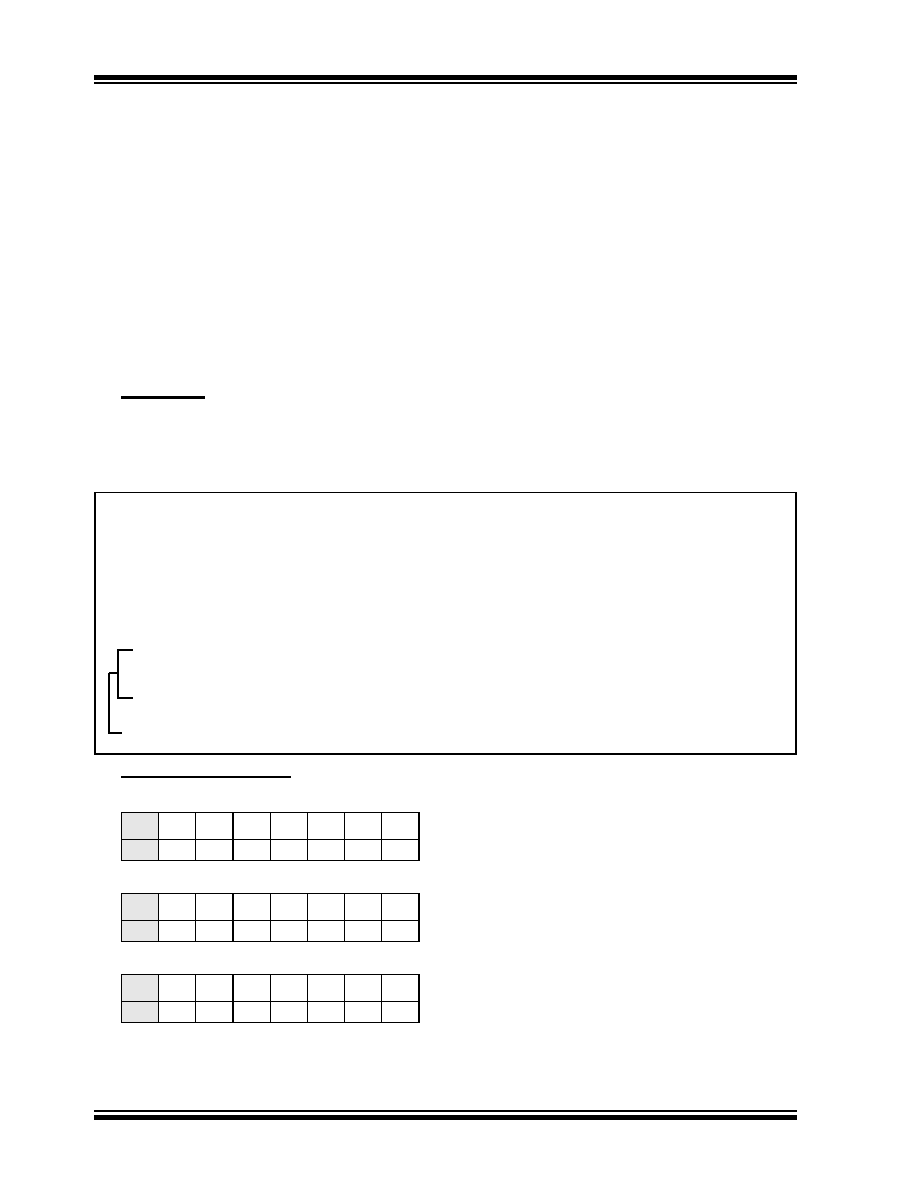- 您现在的位置:买卖IC网 > Sheet目录3873 > PIC16F887-I/P (Microchip Technology)IC PIC MCU FLASH 8KX14 40DIP

PIC16F88X
DS80302F-page 10
2009 Microchip Technology Inc.
8.
Module: Asynchronous Timer1
This Errata supersedes Errata DS80233 and
DS80329.
When TImer1 is started or updated, the timer
needs to see a falling edge from the external clock
source before a rising edge can increment the
counter. If writes to TMR1H and TMR1L are not
completed while the external clock pulse is still
high, Timer1 will not count the first clock pulse
after the update.
When using an external crystal, the pulse width
from
rising
to
falling
edge
is
temperature
dependent and may decrease with temperature.
As a result, the timer may require an additional
oscillation to overflow.
Work around
Switching to the HFINTOSC after reloading, the
timer ensures the Timer1 will see a falling edge
before switching back to the external clock source.
Due to the time from Timer1 overflow to the reload
being application specific, wait for the timer to
increment before beginning the reload sequence.
This ensures the timer does not miss a rising edge
during reload.
EXAMPLE 3:
Affected Silicon Revisions
PIC16F882
PIC16F883/PIC16F884
PIC16F886/PIC16F887
BTFSC
TMR1L,0
GOTO
$-1
BTFSS
TMR1L,0
GOTO
$-1
;Timer has just incremented, 31
μs before next rising edge to
;complete reload
Update:
BCF
T1CON,TMR1CS
;Select HFINTOSC for Timer1
BSF
TMR1H,7
;Timer1 high byte 0x80
BCF
T1CON,TMR1ON
;Timer1 off
BSF
T1CON,TMR1CS
;Select external crystal
BCF
T1CON,TMR1ON
;Timer1 on
Critical Timing of code sequence for instructions following last write to TMR1L or TMR1H.
A0
X
A0
X
A2
X
发布紧急采购,3分钟左右您将得到回复。
相关PDF资料
PIC16CR76-I/SP
IC PIC MCU 8KX14 28DIP
PIC16CR76-I/SO
IC PIC MCU 8KX14 28SOIC
PIC16CR76-I/ML
IC PIC MCU 8KX14 28QFN
PIC16CR74T-I/ML
IC PIC MCU 4KX14 44QFN
PIC16CR74-I/PT
IC PIC MCU 4KX14 44TQFP
PIC16CR74-I/P
IC PIC MCU 4KX14 40DIP
PIC16CR74-I/ML
IC PIC MCU 4KX14 44QFN
PIC16CR73T-I/SS
IC PIC MCU 4KX14 28SSOP
相关代理商/技术参数
PIC16F887-I/PT
功能描述:8位微控制器 -MCU 14KB Flash 368 RAM 36 I/O RoHS:否 制造商:Silicon Labs 核心:8051 处理器系列:C8051F39x 数据总线宽度:8 bit 最大时钟频率:50 MHz 程序存储器大小:16 KB 数据 RAM 大小:1 KB 片上 ADC:Yes 工作电源电压:1.8 V to 3.6 V 工作温度范围:- 40 C to + 105 C 封装 / 箱体:QFN-20 安装风格:SMD/SMT
PIC16F887T-I/ML
功能描述:8位微控制器 -MCU 14KB Flash 368 RAM 36 I/O RoHS:否 制造商:Silicon Labs 核心:8051 处理器系列:C8051F39x 数据总线宽度:8 bit 最大时钟频率:50 MHz 程序存储器大小:16 KB 数据 RAM 大小:1 KB 片上 ADC:Yes 工作电源电压:1.8 V to 3.6 V 工作温度范围:- 40 C to + 105 C 封装 / 箱体:QFN-20 安装风格:SMD/SMT
PIC16F887T-I/PT
功能描述:8位微控制器 -MCU 14KB Flash 368 RAM 36 I/O RoHS:否 制造商:Silicon Labs 核心:8051 处理器系列:C8051F39x 数据总线宽度:8 bit 最大时钟频率:50 MHz 程序存储器大小:16 KB 数据 RAM 大小:1 KB 片上 ADC:Yes 工作电源电压:1.8 V to 3.6 V 工作温度范围:- 40 C to + 105 C 封装 / 箱体:QFN-20 安装风格:SMD/SMT
PIC16F88-E/ML
功能描述:8位微控制器 -MCU 7KB 368 RAM 16 I/O RoHS:否 制造商:Silicon Labs 核心:8051 处理器系列:C8051F39x 数据总线宽度:8 bit 最大时钟频率:50 MHz 程序存储器大小:16 KB 数据 RAM 大小:1 KB 片上 ADC:Yes 工作电源电压:1.8 V to 3.6 V 工作温度范围:- 40 C to + 105 C 封装 / 箱体:QFN-20 安装风格:SMD/SMT
PIC16F88-E/P
功能描述:8位微控制器 -MCU 7KB 368 RAM 16 I/O RoHS:否 制造商:Silicon Labs 核心:8051 处理器系列:C8051F39x 数据总线宽度:8 bit 最大时钟频率:50 MHz 程序存储器大小:16 KB 数据 RAM 大小:1 KB 片上 ADC:Yes 工作电源电压:1.8 V to 3.6 V 工作温度范围:- 40 C to + 105 C 封装 / 箱体:QFN-20 安装风格:SMD/SMT
PIC16F88-E/SO
功能描述:8位微控制器 -MCU 7KB 368 RAM 16 I/O RoHS:否 制造商:Silicon Labs 核心:8051 处理器系列:C8051F39x 数据总线宽度:8 bit 最大时钟频率:50 MHz 程序存储器大小:16 KB 数据 RAM 大小:1 KB 片上 ADC:Yes 工作电源电压:1.8 V to 3.6 V 工作温度范围:- 40 C to + 105 C 封装 / 箱体:QFN-20 安装风格:SMD/SMT
PIC16F88-E/SS
功能描述:8位微控制器 -MCU 7KB 368 RAM 16 I/O RoHS:否 制造商:Silicon Labs 核心:8051 处理器系列:C8051F39x 数据总线宽度:8 bit 最大时钟频率:50 MHz 程序存储器大小:16 KB 数据 RAM 大小:1 KB 片上 ADC:Yes 工作电源电压:1.8 V to 3.6 V 工作温度范围:- 40 C to + 105 C 封装 / 箱体:QFN-20 安装风格:SMD/SMT
PIC16F88-I/ML
功能描述:8位微控制器 -MCU 7KB 368 RAM 16 I/O RoHS:否 制造商:Silicon Labs 核心:8051 处理器系列:C8051F39x 数据总线宽度:8 bit 最大时钟频率:50 MHz 程序存储器大小:16 KB 数据 RAM 大小:1 KB 片上 ADC:Yes 工作电源电压:1.8 V to 3.6 V 工作温度范围:- 40 C to + 105 C 封装 / 箱体:QFN-20 安装风格:SMD/SMT